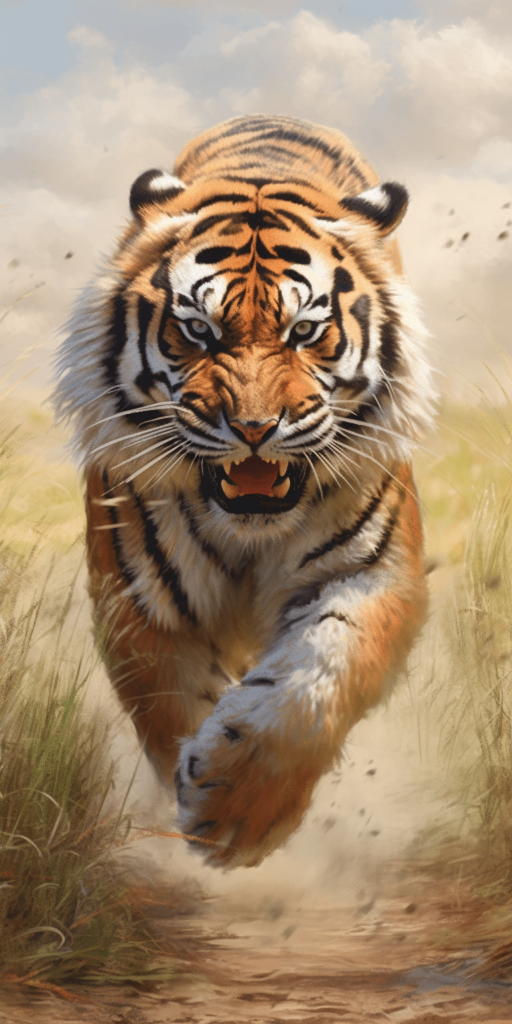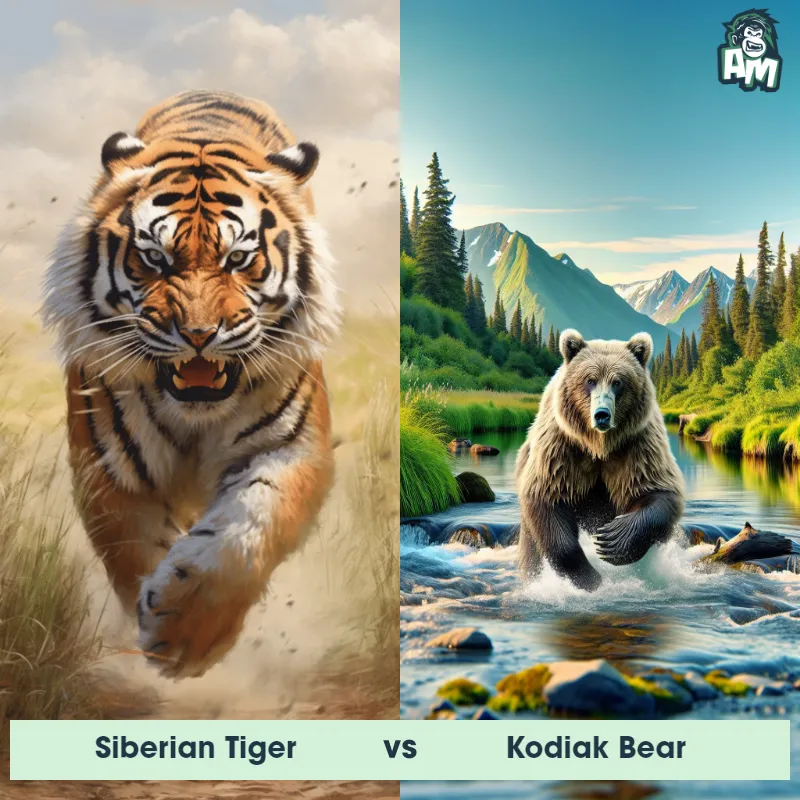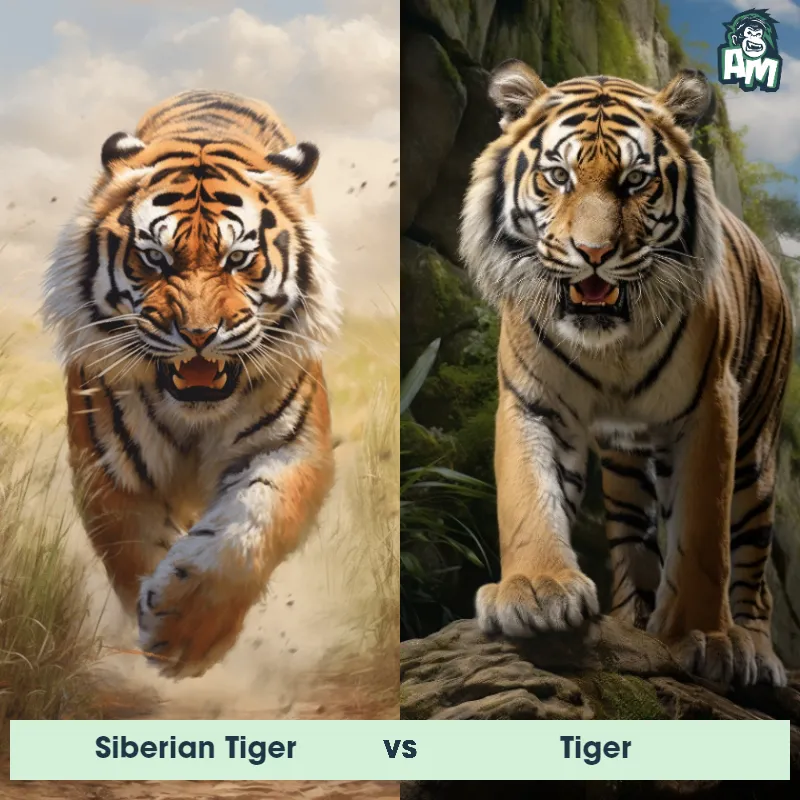The Siberian Tiger
The Siberian Tiger, also known as the Amur Tiger, is the largest cat species in the world, with adult males measuring up to 11 feet in length and weighing over 600 pounds. They have a muscular build, long bodies, and distinctive black stripes on their orange fur. Siberian Tigers are known for their strength and agility, able to run at speeds of up to 50 miles per hour and leap distances of up to 30 feet. They also have large paws and retractable claws that help them climb trees and hunt prey.

| Siberian Tiger | |
|---|---|
| Size | Up to 10 feet (3 meters) in length; up to 3.5 feet (1.1 meters) in height at the shoulder |
| Weight | Up to 660 pounds (300 kilograms) |
| Speed | Speed: 50 mph (80.47 km/hr) |
| Key Strength | Powerful legs and sharp claws |
| Biggest Weakness | Vulnerable to poaching and habitat loss |
| Scientific Name | Panthera tigris altaica |
| Family | Felidae |
| Habitat | Forests and grasslands |
| Geography | Russia, China, and North Korea |
| Diet | Deer, wild boar, bears, and other large prey |
| Lifespan | 10 years - 15 years |

The Siberian Tiger
The Siberian Tiger, also known as the Amur Tiger, is the largest cat species in the world, with adult males measuring up to 11 feet in length and weighing over 600 pounds. They have a muscular build, long bodies, and distinctive black stripes on their orange fur. Siberian Tigers are known for their strength and agility, able to run at speeds of up to 50 miles per hour and leap distances of up to 30 feet. They also have large paws and retractable claws that help them climb trees and hunt prey.
Fun Fact: The Siberian Tiger is an excellent swimmer and is capable of crossing large rivers, often swimming up to 7 miles at a time in search of food or mates.
| Siberian Tiger | |
|---|---|
| Size | Up to 10 feet (3 meters) in length; up to 3.5 feet (1.1 meters) in height at the shoulder |
| Weight | Up to 660 pounds (300 kilograms) |
| Speed | Speed: 50 mph (80.47 km/hr) |
| Key Strength | Powerful legs and sharp claws |
| Biggest Weakness | Vulnerable to poaching and habitat loss |
| Scientific Name | Panthera tigris altaica |
| Family | Felidae |
| Habitat | Forests and grasslands |
| Geography | Russia, China, and North Korea |
| Diet | Deer, wild boar, bears, and other large prey |
| Lifespan | 10 years - 15 years |
Match Highlights
Siberian Tiger Matchups
We use AI to simulate matchups between the Siberian Tiger and other animals. Our simulation considers size, strength, and natural predatory behaviors to determine the most likely outcome.
Siberian Tiger: Diet, Predators, Aggression, and Defensive Behaviors
What do Siberian Tigers eat?
Siberian Tigers are apex predators and primarily feed on large ungulates such as wild boar, deer, and elk. They are also known to prey on smaller animals like rodents, hares, and fish. Occasionally, they may hunt other predators like bears.
Do Siberian Tigers have any predators?
As adults, Siberian Tigers do not have natural predators in their habitat. However, tiger cubs may be vulnerable to attacks by other predators such as bears and leopards.
Are Siberian Tigers aggressive?
Siberian Tigers are known to be solitary and territorial animals. While they are not inherently aggressive towards humans, they will defend their territory if threatened or cornered.
Do Siberian Tigers fight?
Siberian Tigers are known to be solitary animals and will typically try to avoid conflicts with other tigers. However, they may engage in physical fights during territorial disputes or when competing for prey or mates.
How do Siberian Tigers defend themselves?
Siberian Tigers have several defense mechanisms to protect themselves, including their sharp claws and strong jaws. They may also use their size and agility to intimidate or fend off threats. When feeling threatened, a tiger may vocalize, growl, or even charge to defend itself.
What is the Siberian Tiger's biggest weakness in a fight?
Despite their strength and agility, Siberian Tigers do have vulnerabilities in fights, particularly when facing multiple opponents or if they are injured. Their stamina is limited, and prolonged fights can exhaust them, making them more susceptible to defeat. Additionally, their solitary nature may leave them at a disadvantage when outnumbered by competitors.
Fun Fact: Siberian Tigers have a great sense of hearing, aided by their large rounded ears, which can rotate independently to accurately locate sounds from various directions.
Fun Fact: Despite their size and strength, Siberian Tigers are highly elusive creatures and masters of camouflage, blending seamlessly into their forest habitats, making them incredibly difficult to spot.















































